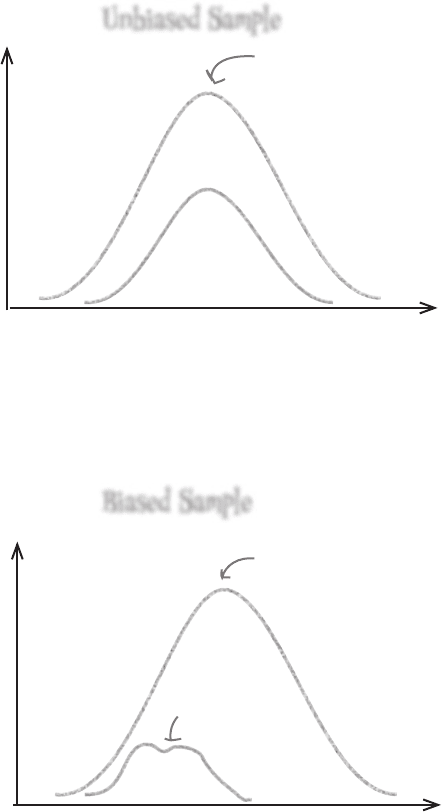Griffiths D. Head First Statistics
Подождите немного. Документ загружается.


you are here 4 421
using statistical sampling
The Case of the Lost Coffee Sales
The Starbuzz CEO has an idea for a brand-new coffee he wants to
sell in his coffee shops, but he’s not sure how popular it’s going to be
with his customers. He asks his new intern to conduct a survey to help
predict the customers’ opinions. The intern will ask customers to taste
the new brew, and tell him what they think.
The intern is really happy to be given such a great opportunity.
First off, he’s been told that if he does the job well, he stands to
get a bonus at the end of the month. Secondly, he gets to give
out free coffee to friendly Starbuzz customers and hear lots of
positive things. Thirdly, he’s been looking for an excuse to talk to
one particular girl who’s a regular visitor to his local coffee shop,
and this could be just the break he needs.
After the intern conducts his survey, he’s delighted to tell the CEO
that everyone loves the new coffee, and it’s bound to be a huge success.
“That’s great,” says the CEO. “We’ll launch it next season.”
When the new coffee is finally launched, sales are poor, and the CEO
has to cancel the range. What do you think went wrong?
Why didn’t the new coffee sell well?
Five Minute
Mystery
Five Minute
Mystery

422 Chapter 10
How to design a sample
You use samples to make inferences about the population in general, and to
make sure you get accurate results, you need to choose your sample wisely. Let’s
start off by pinning down what your population really is, so you can get as
representative a sample as possible.
Define your sampling units
Once you’ve defined your target population, you need to decide what sort of object
you’re going to sample. Normally these will be the sorts of things you described when
you defined your target population. As an example, this could be a single gumball or
maybe a packet of gumballs.
Define your target population
The first thing to be clear about is what your target population is so that you know
where you’re collecting your sample from. By target population, we mean the group
that you’re reseraching and want to collect results for. The target population you
choose depends, to a large extent, on the purpose of your study. For example, do you
want to gather data about all the gumballs in the world, one particular brand, or one
particular type?
Try to be as precise as possible, as that way it’s easier to make your sample as
representative of your population as possible.
We need data about Mighty
Gumball’s super-long-lasting
gumballs, so your target
population is all of the gumballs.
The sampling unit in the taste
test is a single Mighty Gumball
super-long-lasting gumball.
designing a sample

you are here 4 423
using statistical sampling
Define your sampling frame
Finally, you need a list of all the sampling units within
your target population, preferably with each sampling
unit either named or numbered. This is called the
sampling frame. It’s basically a list from which you can
choose your sample.
Sometimes it’s not possible to come up with a list that covers
the entire target population. As an example, if you want to
collect the views of people living within a certain area, people
moving in or out of an area can affect who you have on your
list of names. If you’re dealing with similar objects such as
gumballs, it might not be possible or practical to name or
number each one.
This seems like a
waste of time. Do I have to
do all of these things? Can’t
I just sample gumballs?
If you don’t design your sample well,
your sample may not be accurate.
Designing your sample can take a bit of extra
preparation time, but this is much better than
spending time and money on a survey only to find
the results are inaccurate. You will have lost time
and money doing the survey, and what’s more,
someone might make wrong decisions based on it.
A poorly designed sample can introduce bias.
Let’s look at this in more detail.
Naming or numbering
each gumball maybe
isn’t that practical.
Gumball #1897652
Gumball #1897653
Gumball #1897654
Gumball #1897655
Gumball #1897656
Gumball #1897657
Gumball #1897658
Gumball #1897659
Gumball #1897660
Gumball #1897661
Gumball #1897662
Gumball #1897663
Gumbal4
Gumball #1897670
Gumball #1897671
Gumball #1897672
Gumball #1897673
Gumball #1897674
Gumball #1897675
Gumball #1897676
Gumball #1897677
Gumball #1897678
Gumball #1897679
Gumball #1897680

424 Chapter 10
Sometimes samples can be biased
Not every sample is fair. Unless you’re very careful, some sort of bias can creep
in to the sample, which can distort your results. Bias is a sort of favoritism that
you can unwittingly (or maybe knowingly) introduce into your sample, meaning
that your sample is no longer randomly selected from your population
If a sample is unbiased, then it’s representative of the population. It’s a fair
reflection of what the population is like.
Both means are
the same.
Unbiased samples
An unbiased sample is representative of
the target population. This means that it has
similar characteristics to the population, and
we can use these to make inferences about
the population itself.
The shape of the distribution of an unbiased
sample is similar to the shape of the
population it comes from. If we know the
shape of the sample distribution, we can
use it to predict that of the population to a
reasonable level of confidence.
Biased samples
A biased sample is not representative of
the target population. We can’t use it to make
inferences about the population because
the sample and population have different
characteristics. If we try to predict the shape
of the population distribution from that of
the sample, we’d end up with the wrong
result.
bias in sampling
Biased Sample
duration
frequency
Unbiased Sample
duration
frequency
Sample mean
Population mean

you are here 4 425
using statistical sampling
Sources of bias
So how does bias creep into samples? Through any of the following and more:
A sampling frame where items have been left off, such that
not everything in the target population is included. If it’s not in your
sampling frame, it won’t be in your sample.
An incorrect sampling unit. Instead of individual gumballs, maybe
the sampling unit should have been boxes of gumballs instead.
Individual sampling units you chose for your sample weren’t
included in your actual sample. As an example, you might send
out a questionnaire that not everybody responds to.
Poorly designed questions in a questionnaire. Design your
questions so that they’re neutral and everyone can answer them. An
example of a biased question is “Mighty Gumball candy is tastier than
any other brand, do you agree?” It would be better to ask the person
being surveyed for the name of their favorite brand of confectionary.
Samples that aren’t random. As an example, if you’re conducting
a survey on the street, you may avoid questioning anyone that looks too
busy to stop, or too aggressive. This means that you exclude aggressive
or busy-looking people from your survey.
This sounds hopeless. How can I be certain I
avoid bias? Where does it come from anyway?
You mean I can’t just
try the pink ones???
As you can see, there are lots of sources of bias, and a lot
of it comes down to how you choose your sample.
We need to take a look at ways in which you can choose your sample to minimize
the chances of introducing bias.

426 Chapter 10
Q:
So is the sampling frame a list of
everything that we’re sampling?
A: The sampling frame lists all the
individual units in the population, and it’s
used as a basis for the sample. It’s not the
sample itself, as we don’t sample everything
on it.
Q:
How do I put together the sampling
frame?
A: How you do it and what you use
depends on your target population. As an
example, if your target population is all car
owners, then you can use a list of registered
car owners. If your target population is all
the students attending a particular college,
you can use the college registrar.
Q:
How about things like telephone
listings? Can I use those for my sampling
frame?
A: It all depends on your target population.
Telephone listings exclude households
without a telephone, and there may also
be households who have elected not to be
listed. If your target population is households
with a listed telephone number, then using
telephone lists is a good idea. If your target
population is all households with a telephone
or even all telephones, then your sampling
frame won’t be entirely accurate—and that
can introduce bias.
Q:
Can I always compile a sampling
frame?
A: Not always. Imagine if you had to
survey all the fish in the sea. It would be
impossible to name and number every
individual fish.
Q:
Will I always have to have a target
population?
A: Yes. You need to know what your
target population is so that you can make
sure your sample is representative of it.
Thinking carefully about what your target
population is can help you avoid bias.
If you’re sampling for someone else, get
as much detail as possible about who the
target population should be. Make sure you
know exactly what is included and what is
excluded.
Q: Why is bias so bad?
A: Bias is bad because it can mislead
you into drawing wrong conclusions about
your target population, which in turn can
lead you into making wrong decisions. If, for
example, you only sampled pink gumballs,
your survey results might be accurate for
all pink gumballs, but not for all gumballs in
general. There may be significant differences
between the different color gumballs.
Q:
How can the questions in a
questionnaire cause bias?
A: Bias often creeps in through the
phrasing of questions.
First off, if you present a series of statements
and ask respondents to agree or disagree,
it’s more likely that people will agree unless
they have strong negative feelings. This
means that the results of your survey will be
biased towards people agreeing.
Bias can also occur if you give a set of
possible answers that don’t cover all
eventualities. As an example, imagine you
need to ask people how often they exercise
in a typical week. You would introduce bias
if you give answers such as “more than 5
times a week,” “3–5 times a week,” “1–2
times a week,” and “I don’t value my health,
so I don’t exercise.” Someone may not
exercise, but disagree with the statement
that they don’t value their health. This would
mean that they wouldn’t be able to answer
the question.
there are no dumb questions

you are here 4 427
using statistical sampling
Look at the following scenarios. What would you choose as a
target population? What’s the sampling unit? How would you
develop a sampling frame? What other things might you need to
consider when forming your sample?
1. Choc-O-Holic Inc. manufactures chocolates, and they have just finished a limited-
edition run of chocolates for the holiday season. They want to check the quality of
those chocolates.
2. The Statsville Health Club wants to conduct a survey to see what their customers
think of their facilities.

428 Chapter 10
Look at the following scenarios. What would you choose as a
target population? What’s the sampling unit? How would you
develop a sampling frame? What other things might you need to
consider when forming your sample?
1. Choc-O-Holic Inc. manufactures chocolates, and they have just finished a limited-
edition run of chocolates for the holiday season. They want to check the quality of
those chocolates.
2. The Statsville Health Club wants to conduct a survey to see what their customers
think of their facilities.
The target population is all the chocolates in the limited edition run.
The sampling unit is one chocolate.
The sampling frame needs to cover all of the chocolates; as it’s a limited-edition run, it’s possible that
Choc-O-Holic has records of how many chocolates are in the run, including numbers of each type of
chocolate.
When forming the sample, you need to make sure that it is representative of the target population and
unbiased. If there are different types of chocolate in the run, you’d need to make sure that you included
each sort of chocolate.
The target population is all the customers of the Statsville Health Club.
The sampling unit is one customer.
The sampling frame needs to cover all of the customers. It’s likely that the health club has a list of
registered customers, so you could use this as the sampling frame.
As before, you need to make sure that your sample is representative of the population and unbiased. You’d
need to make sure that each of the classes is fairly represented by customer gender, customer age group,
and so on.
sharpen your pencil solution

you are here 4 429
using statistical sampling
Solved: The Case of the Lost Coffee Sales
Why didn’t the coffee sell well?
We don’t know for certain, but there’s a very good chance that the
sample of people surveyed by the intern wasn’t
representative of the target population.
First of all, the intern was looking forward to giving
away free coffee to friendly Starbuzz customers and
hearing positive things. Does this mean he only spoke
to customers who looked friendly to him? Did he get their
real opinions about the coffee, or did he only ask them whether they
agreed it tasted nice?
The intern also hoped to use the job as an opportunity to speak to a girl
at his local coffee shop. Did he spend most of his time in this particular
coffee shop? Did the girl influence his sample choice?
Finally, the CEO launched the new coffee in a different season from the
one in which the survey took place, and this may have affected sales too.
Any or all of these factors could have lead to the sample being
misleading, which in turn led to the wrong decision being made.
Five Minute
Mystery
Solved
Five Minute
Mystery
Solved

430 Chapter 10
How to choose your sample
We’ve looked at how to design your sample and explored types of bias that need
to be avoided. Now we need to select our actual sample from the sample frame.
But how should we go about this?
Simple random sampling
One option is to choose the sample at random. Imagine you have a
population of N sampling units, and you need to pick a sample of n
sampling units. Simple random sampling is where you choose a
sample of n using some random process, and all possible samples of size
n are equally likely to be selected.
With simple random sampling, you have two options. You can either
sample with replacement or without replacement.
Sampling without replacement
Sampling without replacement means that the sampling unit isn’t
replaced back into the population. An example of this is the gumball
taste test; you wouldn’t want to put gumballs that have been tasted back
into the population.
Sampling with replacement
Sampling with replacement means that when you’ve selected each
unit and recorded relevant information about it, you put it back into the
population. By doing this, there’s a chance that a sampling unit might
be chosen more than once. You’d be sampling with replacement if you
decided to question people on the street at random without checking
if you had already questioned them before. If you stop a person for
questioning and then let them go once you’ve finished asking them
questions, you are in effect releasing them back into the population. It
means that you may question them more than once.
You wouldn’t want to replace
gumballs once you’ve tasted them,
so this would be simple random
samping without replacement.
simple random sampling
